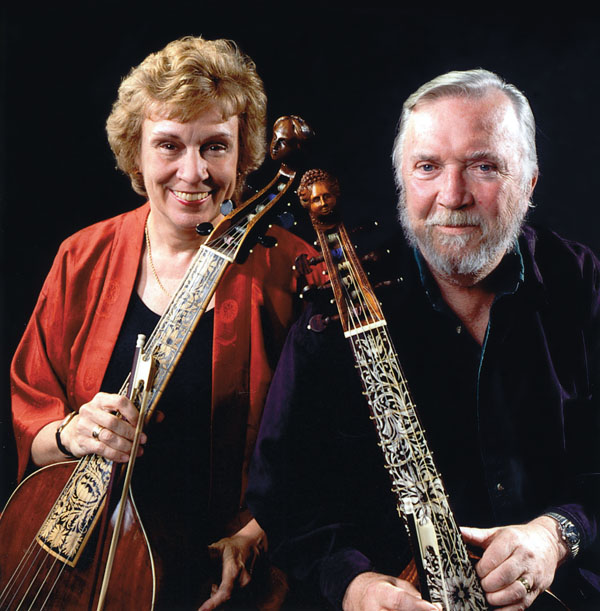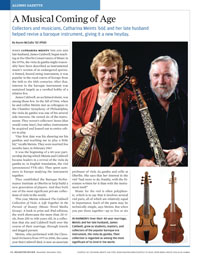Alumni Gazette
 IN HARMONY: Over their 40-year marriage, Meints and her late husband, James Caldwell, grew as students, masters, and collectors
of the popular baroque era instrument, the viola da gamba. Their collection is regarded as among the most significant of its
kind in the world. (Photo: Courtesy of Catharina Meints ’66E)
IN HARMONY: Over their 40-year marriage, Meints and her late husband, James Caldwell, grew as students, masters, and collectors
of the popular baroque era instrument, the viola da gamba. Their collection is regarded as among the most significant of its
kind in the world. (Photo: Courtesy of Catharina Meints ’66E)When Catharina Meints ’66E and her late husband, James Caldwell, began teaching at the Oberlin Conservatory of Music in the 1970s, the viola da gamba might reasonably have been described as instrumental music’s version of an endangered species. A fretted, bowed string instrument, it was popular in the royal courts of Europe from the 16th to the 18th centuries. After that, interest in the baroque instrument was sustained largely as a rarefied hobby of a relative few.
James Caldwell, an acclaimed oboist, was among those few. In the fall of 1966, when he and cellist Meints met as colleagues in the Chamber Symphony of Philadelphia, the viola da gamba was one of his several side interests. He owned six of the instruments. They weren’t collectors’ items (that would come later), but rather, instruments he acquired and loaned out to entice others to play.
“Our first date was his showing me his gambas and teaching me to play a little bit,” recalls Meints. They were married five months later, in February 1967.
It was the beginning of a 40-year partnership during which Meints and Caldwell became leaders in a revival of the viola da gamba or, in English translation, the viol (pronounced VYE-ole). They spent summers in Europe studying the instrument together. They established the Baroque Performance Institute at Oberlin to help build a new generation of players. And they built one of the most significant private collections of viols in the world.
This year, Meints released The Caldwell Collection of Viols: A Life Together in the Pursuit of Beauty (Music Word Media Group). A book in print and iPad editions, the work showcases the more than 20 viols, from 250 to 400 years old, in a collection that she and Caldwell built over the course of their marriage, through travels and dogged pursuit.
Meints, who performed with the Cleveland Orchestra from 1971 to 2006, the same year that Caldwell died, is now an associate professor of viola da gamba and cello at Oberlin. She says that her interest in the viol “had more to do, frankly, with the literature written for it than with the instrument itself.”
Music for the viol is often polyphonic, which is to say that it involves several viol parts, all of which are relatively equal in importance. Each of the parts may be technically simple, says Meints. But when you put them together—up to five or six parts—“they are as complex as a Mahler symphony.”
That also makes the music “conversational,” says Meints. “It’s music written for the pleasure of the players themselves.”
Meints and Caldwell built their collection with musical conversation in mind. “We decided that as we got to know more about instruments and the music we were playing, that we really wanted to have two English instruments and two French instruments and two German instruments, because there was a lot of music for two viols from each of those countries and we wanted to play together,” says Meints.
The Caldwell Collection of Viols features audio supplements of Meints playing each of the instruments in the collection solo. It’s bittersweet. But Kenneth Slowik, artistic director of the Smithsonian Chamber Music Society, and a musician who played many times with Caldwell and Meints, says Meints “brings tremendous cello virtuosity to the viol.” And her solos on each of the instruments make a valuable contribution to musical history. “Hearing them is important for understanding the difference from one school to the next,” he says, referring to distinct English, French, and German viols and viol music.
The book includes photographs, musicological notes, and notes by a contemporary viol maker on each instrument, as well as Meints’s personal story of each acquisition. Slowik, who first met the couple in the early 1970s, describes the book as “an homage”—an homage by Meints to Caldwell and to their joint quest, as described in the book’s subtitle.
Their “life together in the pursuit of beauty” wasn’t just significant to Meints and Caldwell, but to the revival of the viol itself. Meints can take pride that the viol enjoys a higher stature among serious musicians in the United States today than it did 40 years ago.
“There was an active community of amateur players” a half century ago, Slowik says. The growth of professional players is a more recent development, and “the [Baroque] Performance Institute counts among its alums most of the professionals in the early music community. “
Or I should say a certain generation of professionals,” he adds. “In the ’60s and ’70s, there was a real sense of pioneering. Now we’re to the point where a number of younger players can benefit.”

